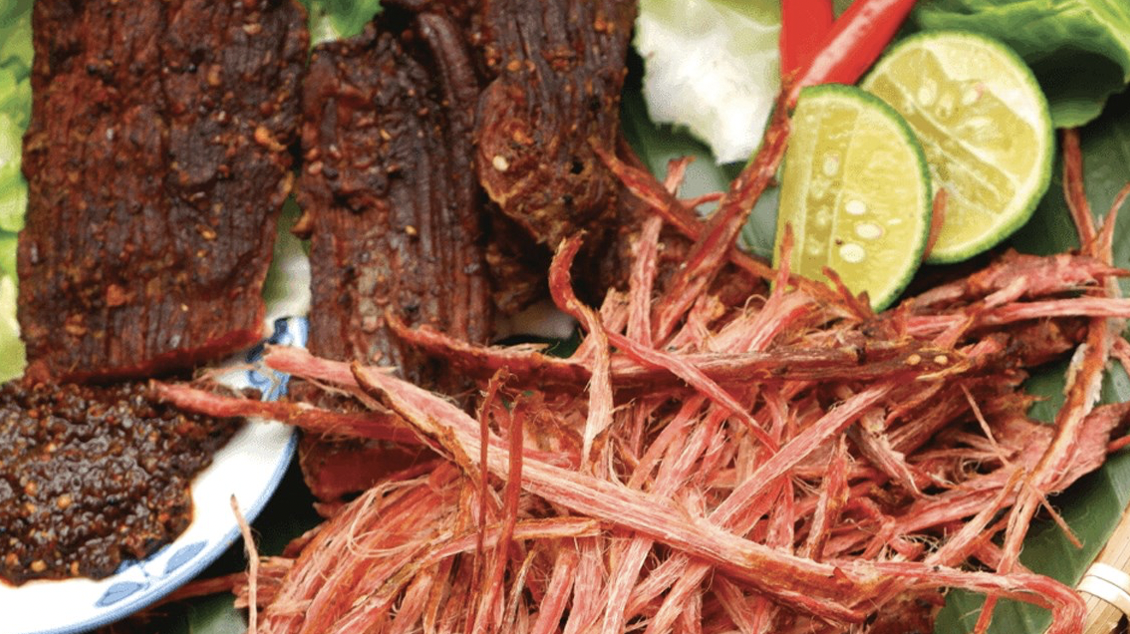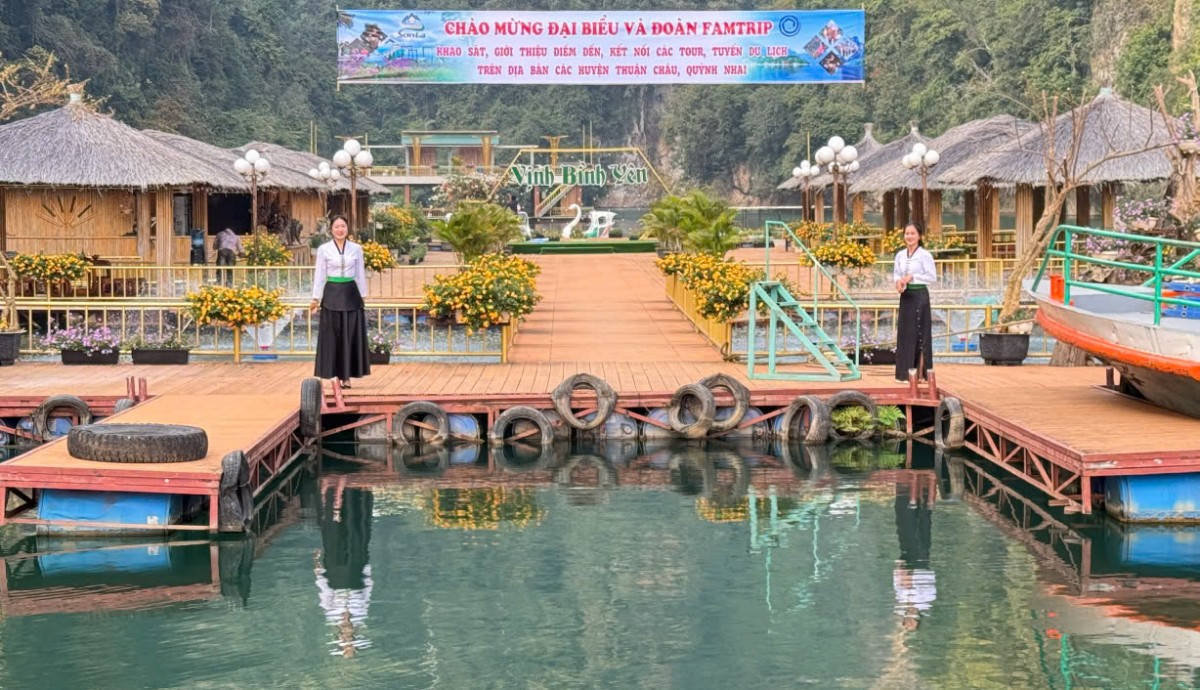Highland products, soul of Son La’s community-based tourism
When villages become destinations with local products being their soul
Community-based tourism has become a key development direction for many highland villages in Son La. Names like Chieng Chau (Mai Chau), Ngoc Chien (Muong La), Hua Tat (Van Ho), and Phieng Cam (Bac Yen) are now familiar to both domestic and international tourists. Visitors come here not just to rest, but to immerse themselves in the local cultural atmosphere, enjoying bamboo-tube rice, sipping local rice wine, watching traditional dances, listening to folklore, and experiencing the daily lives of the Thai, Hmong, Dao, and La Ha ethnic groups.
The rapid development of this tourism model has not only provided sustainable livelihoods for local communities, but also created opportunities to boost the sale of highland specialties – from smoked buffalo meat, Shan Tuyet tea, brocade bags, jars of ‘mac khen’ spice to dried ‘tep dau’ fish – all with the potential to become iconic souvenirs in every traveler’s luggage.
 |
| Each local product is a “silent ambassador.” (Illustrative photo) |
In recent years, community-based tourism in Son La has entered a robust growth phase with successful models, such as Chimi Farm – lush strawberry fields nestled among the hills – and the Plum Festival, where tourists not only enjoy fresh plums, but also take part in lively, culturally rich picking experiences.
Additionally, the Son Tra Tree Festival stands out as a shining example of how cultural preservation can be integrated with tourism development. This native tree species has become a stable source of income for locals, showcasing how ethnic communities are preserving and promoting their unique products while aligning with tourist demand.
Tourism models in villages like Chieng Chau, Ngoc Chien, and Phieng Cam have proven effective when local specialties are incorporated into the tour experience. Visitors not only tour and relax, but also witness and participate in tea harvesting, brocade weaving, and savoring traditional dishes, such as smoked buffalo meat, dried ‘tep dau’ fish, and Shan Tuyet tea.
Son La has also focused on creating display and promotion spaces for local products at tourist sites and organizing training programs for locals on hospitality and visitor engagement. Highland products are not only showcased at trade fairs, but also appear on e-commerce platforms, bringing them closer to tourists and broader markets.
Despite these efforts, highland specialties are still not effectively embedded in the tourism experience. As a result, consumption remains fragmented, spontaneous, and lacks sustainability.
Traveling through various community tourism sites, one can easily observe that local products mostly remain outside the main tourist itinerary. Many visitors leave empty-handed despite being excited about village culture simply because they weren’t introduced to or couldn’t find products to purchase as souvenirs.
In some places, products are sold, but the displays are plain, lacking aesthetic appeal. Packaging and labeling are often basic, making it difficult to compete with industrial goods. Le Minh Hang, a tourist from Hanoi, shared, “I love the tea and buffalo meat here, but I didn’t know where to buy them. The homestay just serves meals. There’s no space for product display or sale.”
These seemingly simple items can become the soul of community-based tourism when told as stories, guided with care, and imbued with cultural meaning. They transform into tangible expressions of identity and culture, cradled in the hands of travelers.
Currently, the lack of product display spaces, quality standards, and trained guides limits the role of local products to that of mere bystanders in the tourism journey.
One major issue is the ineffective integration of local products into tour programs, leaving visitors without opportunities to take home regional specialties. In reality, many locations still lack proper product presentation areas or trained interpreters to explain the origins, meaning, and uses of the products. This limits tourists’ cultural appreciation and hampers sustainable consumption.
Moreover, while products like brocade, tea, and ‘mac khen’ spice are of high quality, they are not widely promoted. Displays often lack visual appeal, packaging is unattractive, and some items are not certified for quality, making it hard to compete with industrial products.
 |
| Son La enchants visitors with its pristine beauty and soulful local products. (Photo: Ngoc Hoa) |
Turning each specialty into a “Silent Ambassador”
To boost the sale of highland specialties, a more synchronized strategy is needed to build a tourism value chain. In a talk with Vietnam Economic News, Nghiem Van Tuan, Deputy Director of Son La’s Center for Investment, Trade and Tourism Promotion, emphasized that community-based tourism cannot thrive without its “small souls” – local products.
“The province is developing agricultural and tourism product display sites at rest stops so that tourists can not only rest, but also access local specialties,” he shared.
In the near future, the province will focus on training specialized guides, supporting the branding of distinctive products, and strengthening linkages with tourism businesses. Alongside training, product promotion and communications will be comprehensively implemented. Highland products now appear not only at fairs and traditional stalls, but also on e-commerce platforms, social media, and at cultural events, allowing tourists to engage with them anytime, anywhere.
When each local specialty is no longer just something to see or taste, but a story told through emotion, pride, and the calloused hands of locals, then community-based tourism has reached its deepest level: human connection.
A pack of Shan Tuyet tea is more than just tea.It’s the soul of the mountains. A piece of brocade fabric is not just a souvenir; it’s cultural color woven through time. A jar of pickled bamboo shoots or a bottle of cham cheo dipping salt, when offered with warmth, becomes a silent ambassador, reaching further than any introduction.
Son La is ready: its villages have ignited the flame; its people are engaged; the policies are in motion. What’s needed now is enduring the synergy between cultural narratives, tourism journeys, and the value of local products so that each trip to the highlands becomes not just a visit, but a return, not just for sightseeing, but belonging.
Community-based tourism cannot be sustainable without its “small souls.” When cherished, those “souls” will become gentle wings, carrying Son La far into the sky of humanistic, green, and sustainable tourism for today and tomorrow.
| Son La needs to improve product quality, develop eye-catching packaging that meets food safety standards, and harmonize traditional craftsmanship with modern technology and market demands. Integrating local products into tour programs requires a methodical approach, with close collaboration among authorities, communities, tourism businesses, and local producers. |
Article URL: https://ven.congthuong.vn/highland-products-soul-of-son-las-community-based-tourism-57353.html
Print ArticleCopyrights of Vietnam Economic News, All rights reserved VEN.VN | VEN.ORG.VN
